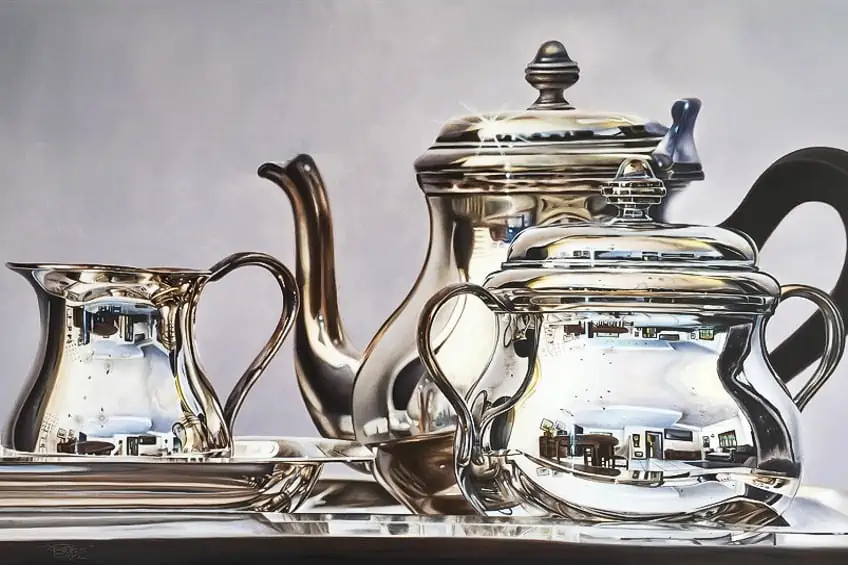Hyperrealism – A Dive into the Best Hyper Realistic Art There Is
The story of Hyperrealism is a story of technology. The invention of photography had a profound impact on art and artists have been using it to create startling images of all variations ever since. As the name suggests Hyperrealism is connected to Realism and Photorealism, with the movements differing mainly through context. Using emerging technologies, artists have continued through numerous revivals.
Explaining the Hype Around Hyperrealism
Hyperrealism is rooted in Photorealism, which came about in the late 1960s, being the first modern movement to acknowledge dependence on photography as part of the artistic process. Although the original makers of Hyperrealistic art were criticized at first for using photography, their work eventually gained recognition.
They played a role in the renewed interest in painting and realism, which surged in the 1970s, continuing into the contemporary moment.
What Is Hyperrealism Art?
Hyperrealism is a movement in art based on using the camera and photographic material to make drawings, paintings, or sculptures that resemble high-resolution photographs. The aim is to reproduce the hard-edged realism of a photograph.
Hyperrealism can also be referred to as photorealism or superrealism.
The subject matter of Hyperrealistic art usually depicts unremarkable, everyday objects, people, and scenes. The method is also banal, often using printers, projectors, grid methods, or transfer paper. Once the photograph has been transposed onto the work surface, the artist recreates and pigments the details of the image. These artists employ techniques that have been used for centuries as well as those at the cutting edge of technology.

Hyperrealistic artists often use tools such as selective focus, depth of field, editing and combining images, cropping, adding, and omitting information to create new versions of reality. Photographic sources are easily manipulated. Various effects can be achieved depending on the kind of camera used. For example, Ektachrome images have blue tones, Kodachrome images look warmer, while digital photography magnifies saturated tones.
With new technological advancements come unprecedented image resolution allowing artists to produce images that are truly hyper-real.
These views go beyond the capabilities of the human eye and allow breathtaking shifts in scale, which are vividly divergent from reality. By expanding the scale from the photographic reference, Hyperrealistic art borrows from the monumentalism of Abstract Expressionist paintings.
The History of Hyperrealism Art
The establishment of linear perspective began the trajectory of Renaissance artists transposing the three-dimensional world onto two dimensions. Artists such as Leonardo Da Vinci developed observational and painting techniques that yielded amazingly realistic scenes. Caravaggio is an artist of this period, famous for bringing biblical characters to life by depicting them as contemporary figures.
Renaissance artists were heavily influenced by the ancient Greeks and Romans who began by representing ideal figures, but once they moved into the Hellenistic Period, they began portraying old age, peasant life, and physical anomalies.
This is a reminder that Realism and Naturalism – this attempt to depict life as we experience it have long been a part of artistic practice. Polychromatic wood sculptures like Dead Christ (1576 – 1635) by Gregorio Fernandez, were made even more lifelike with glass eyes and fingernails made of bull’s horn. This sculpture, which depicts Jesus Christ laid out for burial, was created to be displayed in a church.

Of course, part of the story of Hyperrealism is connected to the Realism movement, which started in the 1850s, and Photorealism, which spanned from the 1960s into the 1970s and 80s. But even before the advent of photography, artists employed optical devices to aid in the painterly process. Many art historians suggest that Vermeer used a mechanism similar to a camera obscura in the making of his paintings.
Contemporary artist David Hockney’s book and documentary Secret Knowledge: Rediscovering the Lost Techniques of the Old Masters (2001), suggests that the pivotal shift in art happened in 1816 with the invention of chemicals that gave rise to photography, which enabled photographic images to become fixed.
Photographic processes like the Daguerreotype and Calotype were developed in England and France in the early 1800s.
As the groundbreaking technology improved and became more accessible, it forced western painting to become more experimental, colorful, large, expressive, and confrontational to compete. Photography itself eventually became a recognized art form in its own right, but ever since its arrival artists began using it in their practice, putting it in constant conversation with other media.
Realism
Before the 1800s, the art-making process was governed by strict rules. Influenced by Positivism, which prioritized the real and tangible, Realism rejected the academic doctrine, which strove towards ancient Greco-Roman ideals and dictated that subject matter be mythological, historical, or religious. However, neither Realism nor its sister movement Naturalism was anything new. Instances of Realism can be found from the origins and throughout the evolution of art history.
Realism emerged in the mid-19th century in Western Europe around the time photography had been invented. As a result, photography influenced many aspects of human existence, including art.
Realism was considered one of the first Modern art movements, noted for its focus on the everyday lives of working-class people. The French art critic Champfleury (1821 – 1889) was the first to use the term Realism while describing Gustav Courbet’s work in the 1840s.
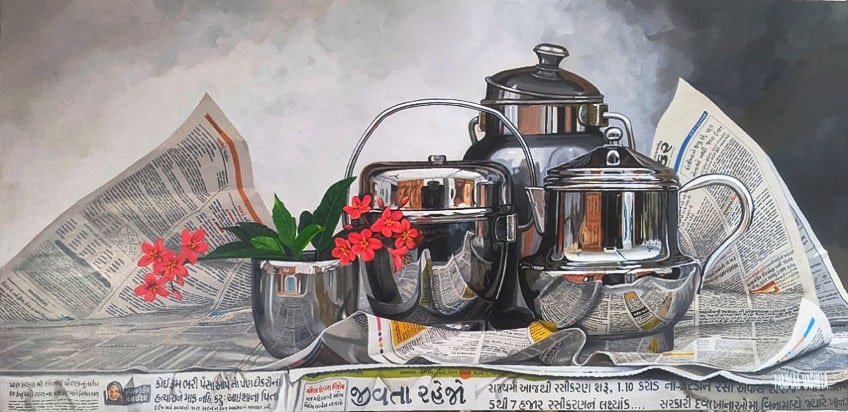
The quintessential realist painter Gustave Courbet (1819 – 1877) used photographs of nude women as a reference for many of his most famous artworks. The landscape painter Albert Bierstadt was among the first to harness the new technology, painting from stereoscopic photographs captured by his brothers. Nadar made the photograph Standing Female Nude (1860 – 1861) for the use of artist Jean-Léon Gérôme assisting in his process of painting Phryne Before the Areopagus (1861).
In addition to photography, Courbet was also influenced by Spanish golden age painters such as Velasquez and 17th-century Dutch painters like Rembrandt and Hals who depicted their realities with incredibly realistic effects.
The first concretely realist painting, Stone Breakers (1849) was sadly wrecked in World War II. Courbet once said, “Show me an angel, and I’ll paint one”. With this statement, Courbet meant that he was only interested in painting what he saw around him. He wanted his paintings to depict everyday people and places that existed in his lifetime. His images would be less idealized and grittier.

This artwork ostensibly stands as a narrative of poverty, depicting two members of the lower class, without showing much of their faces. Somehow anonymity becomes an important principle of realism. As so many people experience poverty, the figures in this painting could be anyone. As stone breakers, the two figures are seen performing the menial but laborious task of breaking big stones into smaller stones, which would then be used for paving roads.
Stone Breakers was a reaction to the poor working conditions of industrial Europe and the ensuing series of large-scale labor strikes starting in 1848.
This painting itself is rather large. Its monumental size elevates a commonplace event to a grand, or historical scale to increase impact. Courbet hired two stone breakers he had seen on the side of the road to pose for his painting, noting that the figures’ ages were intended to show how people were born and died in poverty. Courbet’s oil on canvas work The Meeting (1854) is a famous representative of this movement. Inspired by the industrial revolution and the working class, the invention of photography, showed the political and social importance of the working class.
Photorealism
In the 1950s and 60s, artists began rejecting representation through abstraction. At the peak of high modernism pop art, conceptual art, performance, Fluxus, identity art, feminist art, abstract expressionism, pure abstraction, concept art, process art, post-minimalism, light, and land art became the standard for much of the 20th century. At a certain point, these had been fully realized and there was no room left to expand. It stands to reason that there were artistic revivals and a return to representation.
A group of artists working mainly in New York and California started using photographs as the primary material and foundation for producing realistic and detailed paintings.
Initially, the aesthetic was a rejection of the non-objective, Abstract Expressionist, Minimalist, and consumer-based imagery of Pop Art dominant during mid-20th century American art. The term Photorealism was coined by the writer and gallerist Louis K Meisel in 1969 to refer to the group of artists in question.

In his definition of Photorealism, Meisel necessitated the use of a camera to capture an image that had to be transferred to a work surface by mechanical or semi-mechanical means. While the modernists used brush marks and artistic touch to heighten the level of expression, these artists sought to remove that level of expression through their incredibly technical means. Despite this, their images drew inspiration from Pop Art and Abstract Expressionism.
Like Realism, Photorealism often depicted ordinary scenes of everyday life. From Pop Art, Photorealism borrowed its focus on the consumer culture and advertising prevalent in most parts of post-World War II America.
Indeed, this type of Photorealism did not resemble the soft romantic or hard-edged realism of the 19th century, nor was it concerned with ideal, historical, or social narrative. Instead, this more accurate style of painting sought only to mimic the aesthetic quality of a photograph, capturing with immaculate precision every detail of often mundane subject matter.
Hyperrealistic Painters and the Essence of Being
From around the 1960s to the 1980s Hyperrealism as we know it took shape. Inspired by the new possibilities of photography, Hyperrealistic painters used photographic references taken from a variety of sources as a basis for their paintings. Hyperrealistic paintings tended toward a rather dehumanizing aesthetic. The most popular hyperrealist painters avoided the faces of their subjects who are often looking away from the viewer.
While there is certainly no shortage of hyperrealist portraiture today, the first generation of hyperrealist painters tended to prefer objects, particularly those with reflective surfaces.
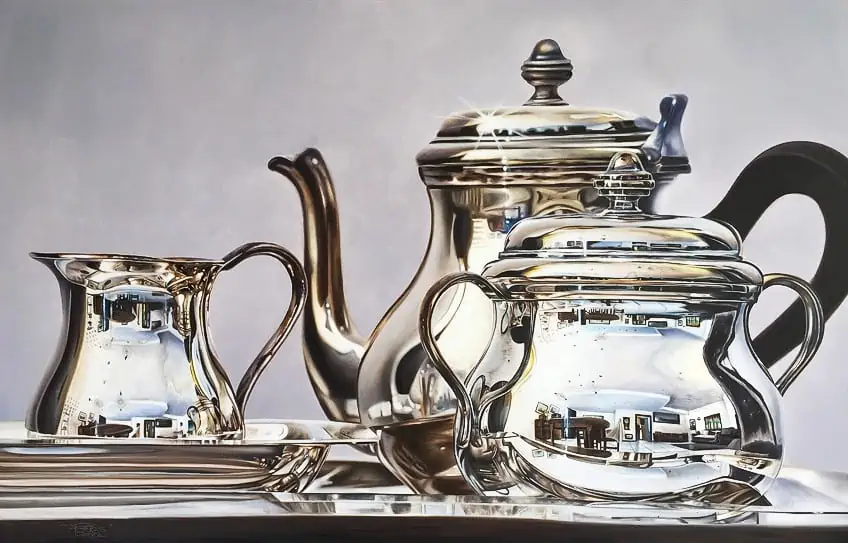
Hyperrealistic paintings often depict reflective surfaces as seen in Richard Estes’ Telephone Booths (1968) or Ralph Goings’ Ralph’s Diner (1982). These reflective surfaces are so meticulous they produce various reflections distorting images, and pushing them back toward abstraction. These are usually painted in oil or acrylic, and like many artists throughout history, hyperrealist painters use tools to enhance realistic effects.
The grid system or projectors that transpose images are the most common methods in Hyperrealistic painting. The finished products often opt for impressively large scale.
Famous Hyperrealist Painters
The first generation of Hyperrealistic painters worked in the 1960s and 1970s. They were interested in the ordinary aspects of American life. Their paintings depicted American towns and classic Americana scenes such as roadside eateries, American diners, and other aspects of urban and suburban landscapes including motorcycles, cars, and trucks. One of the most legendary of the first generation of Photorealist artists Don Eddy was known for his depictions of cars and motorbikes.
Ralph Goings (1928 – 2016)
| Artist Name | Ralph Goings |
| Date of Birth | 9 May 1928 |
| Date of Death | 4 September 2016 |
| Place of Birth | California, United States |
| Associated Art Movements | Hyperrealism |
| Nationality | American |
Ralph Goings’ Ralph’s Diner (1982), provides another example of the reflective surfaces preferred by hyperrealist painters. Without a brushstroke in sight, the shiny chrome surface shimmers with pure hard-edged, and beautiful detail. Once again, the figures are coldly depicted facing away from the viewer.
Because of his supposedly random subject matter, Ralph Goings is a quintessential example of a hyperrealist painter.
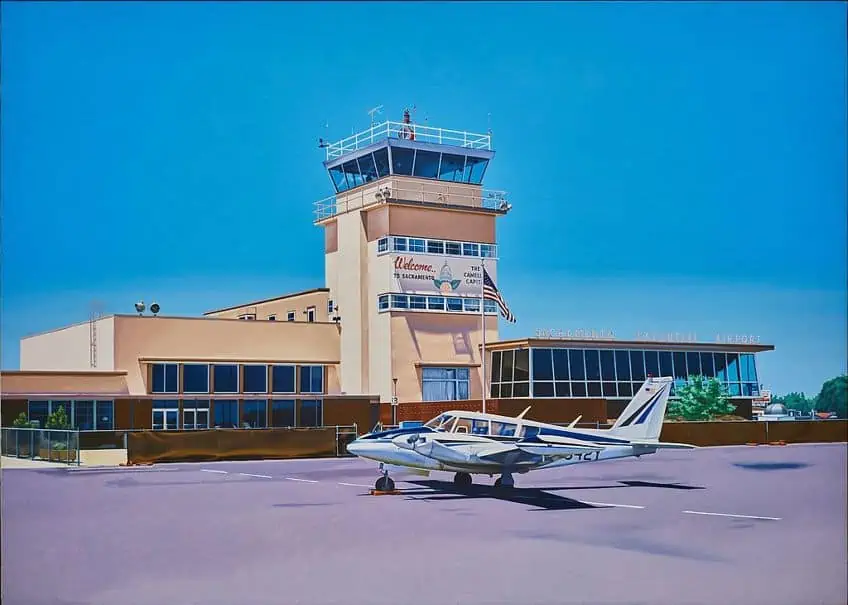
Goings preferred pop cultural symbols like McDonald’s, trucks, and airstream trailers, as seen in his iconic work McDonald’s Pickup (1970) or Airstream (1970). Part of the reason why these reflective surfaces were so appealing to hyperrealist painters is that they wanted to show off their photorealistic prowess.
A painting like Airstream is made more impressive because of the technical challenge of painting hard and reflective surfaces.
Audrey Flack (1931 – Present)
| Artist Name | Audrey Flack |
| Date of Birth | 30 May 1931 |
| Date of Death | N/A |
| Place of Birth | New York, United States |
| Associated Art Movements | Hyperrealism |
| Nationality | American |
Audrey Flack’s compositions were made entirely of everyday objects giving them the illusion of Pop Art assemblages, or neo-Dadaist collages. These are not collages, but still-life oil and acrylic paintings lusciously beautiful and painstakingly rendered, often following the 17th-century Vanitas painting tradition. Objects like fruits, roses, and lipstick reference notions of femininity, lusciousness, and desirability, making Flack’s work symbolic.
The impersonal Hyperrealistic technique removes the artist’s touch, emphasizing the work’s semiotics.
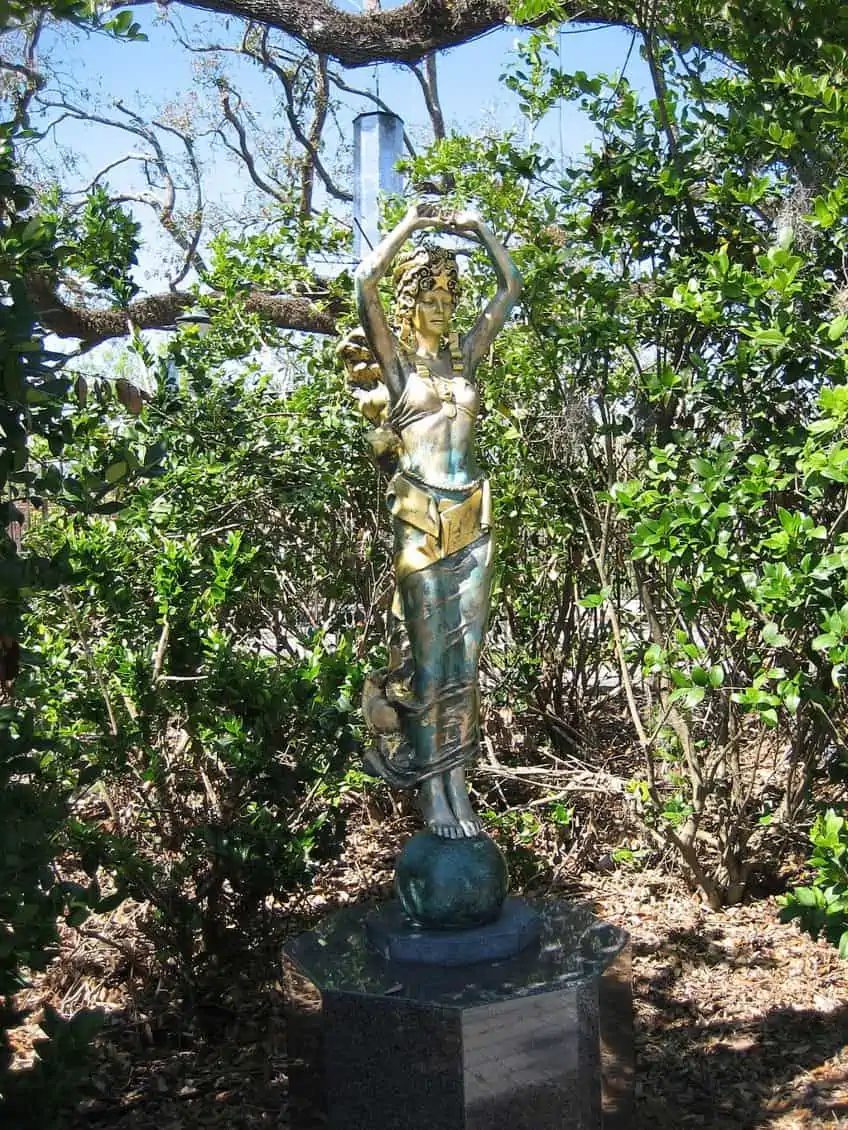
Symbolism is a classic pop culture trope, which when combined with the consumer-like nature of the objects depicted, gives the work a distinct Pop Art sensibility. Flack’s work Queen (1976) depicts both the queen from the chess set and the queen of hearts from a deck of cards.
The Hyperrealistic assemblage of objects also includes a little compact of photos of lip balms, oranges, and a rose.
Richard Estes (1932 – Present)
| Artist Name | Richard Estes |
| Date of Birth | 14 May 1932 |
| Date of Death | N/A |
| Place of Birth | Chicago, United States |
| Associated Art Movements | Hyperrealism |
| Nationality | American |
Telephone Booths (1968) by Richard Estes is a classic example of Hyperrealism as it references both pop art and abstract expressionism. The Telephone Booths themselves are a favorite subject matter for Estes. They’re mass-produced objects. On them are reflections of advertisements, storefronts, and other texts all referencing popular and consumer culture.
The Telephone Booths are chrome, shiny, and new. Their reflective surface produces a random quality reminiscent of abstract expressionism.
Seemingly by choosing such reflective surfaces and precisely replicating them from photographic reference, artistic freedom is foregone, but the reflections create wonderful abstract details marking a marriage between Pop Art, Abstract Expressionism, and Hyperrealism. As the technique is quite reductive it limits the human element and there are almost no depictions of people in these depersonalized environments. When we do see people, as we do in Telephone Booths, we see them from behind.
Objects are the focus of hyperrealist paintings as they are in Pop Art.
Chuck Close (1940 – 2021)
| Artist Name | Chuck Close |
| Date of Birth | 5 July 1940 |
| Date of Death | 19 August 2021 |
| Place of Birth | New York, United States |
| Associated Art Movements | Hyperrealism |
| Nationality | American |
Chuck Close is probably the most well-known of the Photorealists. His work is largely based on portraits of his friends and associates. Close’s technique entailed gridding out a photograph and transposing it on a colossal scale to the point where the pores of the figure were legible. The image Study for Self-portrait (1968), which is roughly 18 by 13 inches, reveals the grids Close used to mark the photographs in preparation for the painting process. The final painting, Big Self Portrait (1968), measures 107 ½ by 83 ½ inches. The level of detail at such scales was not only unflattering but dehumanizing.
Chuck Close was aware of and actively experimenting with the dehumanizing coldness of Hyperrealism.
He developed various Hyperrealistic techniques like multiple, overlaying fingerprint layers for the light and dark areas in the construction of Phil/Fingerprint (1981), painting these on a colossal scale. By the 1980s, Close had begun mixing colors within each grid section in his painting process giving the work a pixelated or even Divisionist quality.
Each grid would be filled with a series of circles, lines, or smudges so that up close they appear completely abstract, but at arm’s length, the image looks like a photograph.
Hyperrealist Sculptors and the Uncanny Valley
Of course, Hyperrealism also extends into the third dimension and this fact is also nothing new. Despite the pristine white marble presented to us in popular culture, we know that ancient Greek sculptures, would have been painted, likely in naturalistic colors, even including a wax coating to give them a lifelike translucence.
Ancient Greek artists would even have painstakingly painted hair on their precious sculptures.
The photorealistic sculpture then could be said to be descending from this timeless striving in the ancient world. Hyperrealist sculptors also strive for a likeness that is so striking, that it produces an uncanny sense of the figure’s living presence. Once again, while Hyperrealist sculptors borrow from these ancient legacies, their revivals can be read completely anew. Their figures aren’t idealized or heroic like the ancient Greeks, nor are they bound by the romantic naturalism of the 19th century. Contemporary Hyperrealist sculpture is often unideal and unnerving figures.
Duane Hanson (1925 – 1996)
| Artist Name | Duane Hanson |
| Date of Birth | 17 January 1925 |
| Date of Death | 6 January 1996 |
| Place of Birth | Minnesota, United States |
| Associated Art Movements | Hyperrealism |
| Nationality | American |
The uncanny feeling of encountering Hyperrealist sculpture is palpable in the work of Duane Hanson, perhaps one of the best-known of the Hyperrealist sculptors. Hanson took life casts from his subjects and meticulously painted the casts until they looked life-like, applying hair, including arm hair and finally clothing them and giving them props. His works Tourists (1970) and Supermarket Shopper (1970) are examples of these unnerving creations.
During the 1970s, Hanson was limited by the available technology and began working in fiberglass and polyester resin giving his figures rather artificial surfaces.
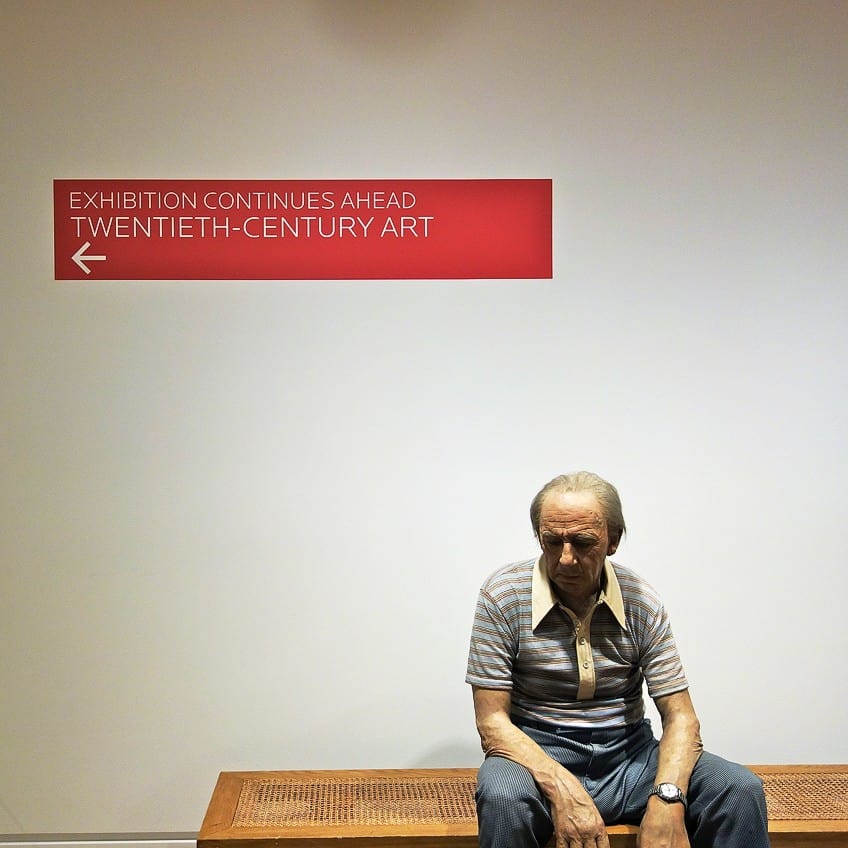
Over time, the technology and techniques improved until works like Queenie II (1988) were like having a living person in the room. By picking rather mundane subjects like Queenie the custodial worker, tourists, or an ordinary shopper, Hanson depletes the idealism from the work of art, increasing the sense that it has a presence.
Not only does this rhetoric borrow from Pop Art, but Realism.
It forces the viewer to confront the reality of these objects that represent people in this most uncanny manner. The uncanny valley represents the anthropomorphizing of realistic man-made objects, even though their Hyperrealism is unnerving.
Ron Mueck (1958 – Present)
| Artist Name | Ron Mueck |
| Date of Birth | 9 May 1958 |
| Date of Death | N/A |
| Place of Birth | Melbourne, Australia |
| Associated Art Movements | Hyperrealism |
| Nationality | Australian |
Ron Mueck who is one of the most famous Hyperrealist sculptors has a background in practical effects for the film industry. When he decided to pursue sculpture, his experience in practical and special effects helped him master the casting and technology he used to create Hyperrealist sculpture.
Mueck chose to work with silicone which has more translucence allowing it to more closely resembles human flesh.
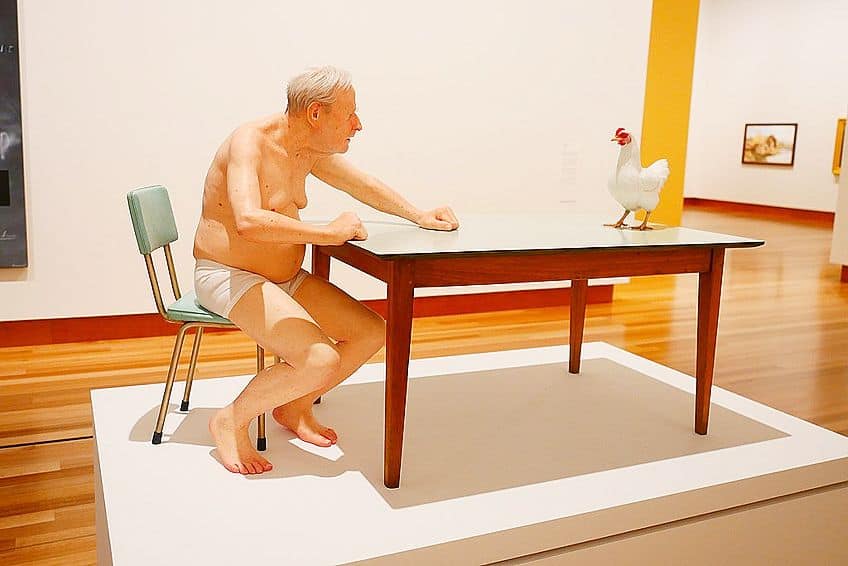
But even though his figures look Hyperrealistic, Mueck subverts the scale, making the figure much smaller or larger than life-size. This bizarre intervention amplifies the unnerving quality of the work Boy (2000) and Untitled (Big Man) (2000) are gigantic in scale yet still retain their silicone lifelike surfaces, with everything down to each individual hair follicle having been laboriously threaded into place creating an eery quality of life. Wild Man (2005) could have easily been mistaken for a living person sitting on a chair. Each detail on his hand is accurately rendered.
The signifier that pulls the viewer back into the realm of sculpture is the impossible scale.
The New Generation
The third generation of Hyperrealism art emerged in the 1990s and 2000s. These artists are harnessing digital technology to aid them with their Hyperrealistic art. This generation has become more precision-oriented in their processes of depicting a photograph on canvas and methods through which they could become more adept at Hyperrealism.
The ever-changing technology has allowed these artists to use computer-generated stencils and extremely high-resolution digital cameras, pushing Hyperrealism art to the extreme.
Today’s Hyperrealistic art far exceeds what was once thought possible through painting. But Hyperrealism art is more popular than ever because of its democratic nature. Although enthusiasts are often impressed by the technicalities of photorealism, methods like gridding are rather accessible. There are thousands upon thousands of people all around the world making Hyperrealistic art and sharing it all over social media like YouTube or Facebook.
Arinze Stanley Egbe (1993 – Present)
| Artist Name | Arinze Stanley Egbe |
| Date of Birth | 20 November 1993 |
| Date of Death | N/A |
| Place of Birth | Lagos, Australia |
| Associated Art Movements | Hyperrealism |
| Nationality | Nigerian |
Nigeria is a country that has come to be known for its multitudes of Hyperrealistic artists who went viral on the internet. Arinze Stanley Egbe is one such Nigerian artist who became popular for his Hyperrealistic life-size portraits of black African people made from the artist’s preferred medium of charcoal and graphite on paper.
Although he had been drawing since he was six years old, it wasn’t until 2012 when he discovered artists making Hyperrealistic art on social media that he knew that that was his calling.
He hasn’t stopped drawing since. Thanks to social media Egbe’s work has received international attention making him one of the most popular contemporary Hyperrealism artists. As a result, Hyperrealistic art has proved to be quite lucrative for Arinze.
Limits and Gimmicks
The critics of Hyperrealism have declared the movement intellectually inept. Its practitioners have been accused of being skilled copyists at best and frauds at worst. If the entire process is based purely on technical tricks or formulas, then the work can be seen as having no substance.
While the appeal of Hyperrealism is obvious and warranted, its precision may limit artistic expression and blur the line between skill and gimmick.
Other critics question the value of simply reproducing images that already exist. By attempting to realistically render photographs in paint, Hyperrealists could be accused of making the purpose and impact of both media ineffective. As both painting and photography have proven themselves as invincible disciplines of art, Hyperrealistic art can have the appearance of redundancy.
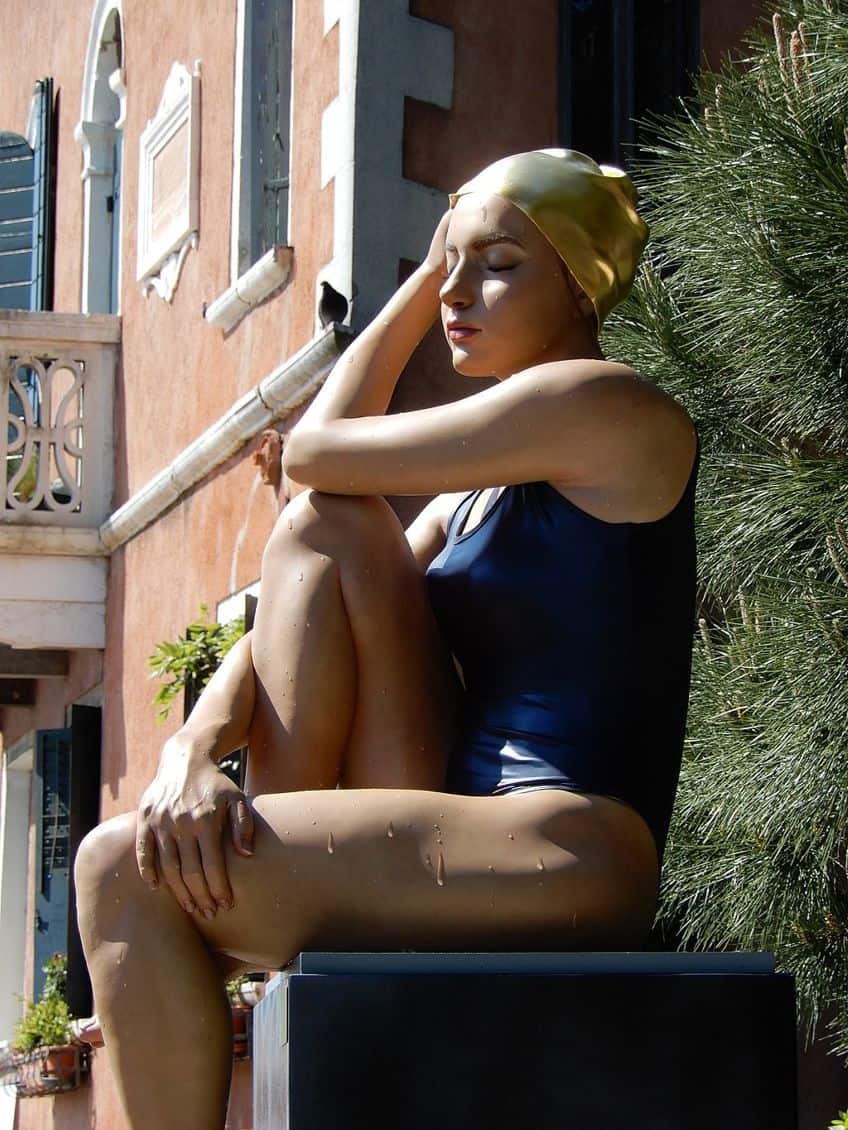
While these criticisms should be recognized for their validity, the popularity of Hyperrealism is undeniable. Hyperrealism has given millions of people easy access to art, which sometimes struggles from the unpleasant impairment of exclusivity. Indeed, Hyperrealism has opened the door for the masses to become artists themselves through gridding, projectors, and other easily accessible Hyperrealism art techniques.
Thanks to Hyperrealism, there are probably more artists today than ever before.
Hyperrealism art techniques can be demanding, but any committed person can achieve Hyperrealistic art. While the strict technical treatment of subject matter requires a flat application of paint resulting in a deadpan aesthetic, this has done nothing to deter the proud proponents of Hyperrealistic art who continue to harness the value in the detachment of the camera lens for their own ends.
Believe the Hype
Despite this criticism, Hyperrealism has endured and been adopted by subsequent generations of artists. Because it is impressive in its technical quality, realism continues to gain popularity and play a part in the story of art.
Hyperrealism is admired partly because of the time and patience it can take to transform mere art supplies into images and sculptures that can so closely resemble photographs, objects, or people in the real world.

The minute detail and the sheer amount of time that goes into creating something like that spark a degree of awe that invites us to ponder the finite moment at which the photograph was taken, compared to what it can take for the image to be transposed to its new form.
The pursuit of aesthetic perfection also provides catharsis for the artist and the viewer. The time that it takes to produce one of these artworks contributes to the awe a viewer feels when observing a perfectly executed artwork. This type of art encourages the viewer to take a closer look. Realism challenges the viewer’s perception of reality. In the photorealist tradition, viewers are awed in part because they know the illusion is not real. Even at its best, Hyperrealism reminds the viewer that there is a perfect representation and, in the process, Hyperrealist artists construct new realities.
Take a look at our Hyperrealism art webstory here!
Frequently Asked Questions
Is Gerhard Richter a Hyperrealist?
Gerhard Richter has moved between many different forms of painting throughout the years but the Hyperrealist painting Betty (1988) is one of his best-loved works. Richter’s portraits are not often intimate but Betty comes close to being a classic portrait. The artist precisely paints his daughter with her head turned away in a manner that reminds one of Johannes Vermeer’s Girl with a Pearl Earring (1665).
Is Ai Weiwei a Hyperrealist?
Sometimes. Ai Weiwei’s porcelain sculpture Kui Hua Zi [Sunflower Seeds] (2009) is an exquisitely crafted example of a Hyperrealist sculpture.
Why Did Hyperrealism Come About?
Particularly after photography became such a prominent part of art and life, many artists were uninspired by the conceptual and abstract movements of the 1960s because these were not technically challenging enough for them.
Jordan Anthony is a Cape Town-based film photographer, curator, and arts writer. She holds a Bachelor of Art in Fine Arts from the University of the Witwatersrand, Johannesburg, where she explored themes like healing, identity, dreams, and intuitive creation in her Contemporary art practice. Jordan has collaborated with various local art institutions, including the KZNSA Gallery in Durban, the Turbine Art Fair, and the Wits Art Museum. Her photography focuses on abstract color manipulations, portraiture, candid shots, and urban landscapes. She’s intrigued by philosophy, memory, and esotericism, drawing inspiration from Surrealism, Fluxus, and ancient civilizations, as well as childhood influences and found objects. Jordan is working for artfilemagazine since 2022 and writes blog posts about art history and photography.
Learn more about Jordan Anthony and about us.
Cite this Article
Jordan, Anthony, “Hyperrealism – A Dive into the Best Hyper Realistic Art There Is.” artfilemagazine – Your Online Art Source. October 17, 2022. URL: https://artfilemagazine.com/hyperrealism/
Anthony, J. (2022, 17 October). Hyperrealism – A Dive into the Best Hyper Realistic Art There Is. artfilemagazine – Your Online Art Source. https://artfilemagazine.com/hyperrealism/
Anthony, Jordan. “Hyperrealism – A Dive into the Best Hyper Realistic Art There Is.” artfilemagazine – Your Online Art Source, October 17, 2022. https://artfilemagazine.com/hyperrealism/.


